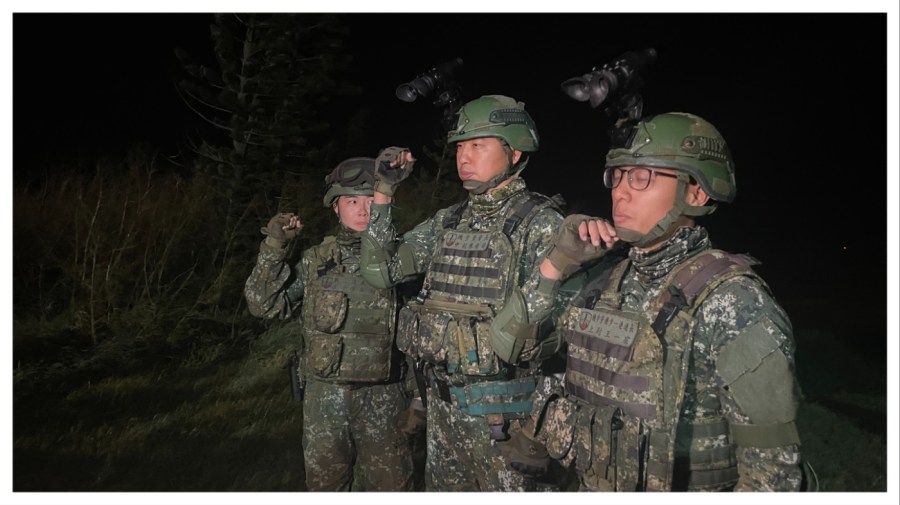PENGHU ISLANDS, Taiwan — First came the flares, launched just offshore to erase the darkness with a bright orange glow.
Then came the light machine guns, fired from several positions across the cliff face toward the ocean, now lit by the arcing flares.
Finally, Taiwanese forces brought in the tanks, which rumbled to the cliff edge and lined up in a row before thundering cannons at the illuminated waters.
Taiwan’s Army carried out a nighttime training exercise on Thursday night, preparing for a scenario in which Chinese forces launch an attack with drones and boats in the darkness.
The military drill was the first time that press was invited to witness a nighttime exercise, and it shows how Taiwan is preparing for all scenarios should China invade or launch an attack on the self-governing island nation.
With 2027 fast approaching — the date Chinese leader Xi Jinping has set for a potential attack on Taiwan — Taipei is bracing for an encounter, whatever that might look like.
Lt. Col. Chen Xiong, commander of the Air Force Battalion, said the focus of the exercise was to “train officers and soldiers to be familiar with the battlefield at night.”
“This night [mission] is mainly to let the officers and soldiers be familiar with the operation of the night equipment and adapt to the multi-station environment at night,” he told reporters after the exercise.

The recent drill took place near the city of Magong on the Penghu Islands, an archipelago on the Taiwan Strait that is sandwiched between the Taiwanese mainland and China.
At a base called Wu-De, a Taiwanese Army battalion fired for more than 30 minutes off a cliff into the surrounding waters.
The “Zhenjiang Exercise” involved the firing of some 200 mortars, 40 grenade-launched projectiles and 50 machine guns, according to the Taiwanese military.
Taiwan also deployed several M60A3 tanks and CM21 armored personnel carriers, which carried troops to the shore to line up and fire M249 light machine guns from tactical positions.
In the scenario, Chinese ships are threatening from the sea, so the Army deploys to the shore to fire at drones and naval vessels.
Infantry were primarily aiming for imaginary drones in the sky, while the tanks fired lower in the air, toward imaginary ships. There were no actual targets in the drill.
Capt. Wang Yichen, commander of the 1st Machinery Infantry Battalion, said the exercises indicated his forces were ready to protect Taiwan.
“We will be able to enhance our modern experience and help our brothers and sisters,” he told reporters.
Tensions between China and Taiwan have been steadily growing in the past few years as Xi has pledged to reunify with Taiwan, which Beijing considers part of the mainland. The Republic of China, the government in Taiwan, fled the mainland in 1949, escaping a communist takeover.
The inauguration in May of Taiwanese President Willaim Lai Ching-te has only escalated tensions. Lai is pro-U.S. and has been forceful about defending Taiwan from Chinese aggression.
At a ceremony for Taiwan’s National Day earlier this month, Lai said he would “uphold the commitment to resist annexation or encroachment” from China, prompting Beijing to launch massive drills by sea and air just days later.
The U.S., which does not officially recognize Taiwan’s independence but commits to arming and supporting the self-governing country, is vital to any defense of Taipei should China attack.
But Taiwan’s military will still play a huge role in any conflict, and the first bursts of fighting in the event of a war are expected to take place between Taiwanese and Chinese forces.
Taiwan’s outlying islands are likely the first targets for any Chinese attack, considering they are isolated from the mainland. Besides Penghu, targets on the outskirts include Kinmen, which is just a few miles away from China.
Lai visited Kinmen on Friday and invoked the 1949 Battle of Guningtou, in which Taiwanese forces beat back a Chinese assault on the island.
“The Battle of Guningtou makes us realize that democracy and freedom are not something to be taken for granted,” Lai said, according to several news reports. “We treasure a democratic and free way of life, and we cannot, and will not, allow any external force to change the future of Taiwan, Penghu, Kinmen and Matsu.”
Many Taiwanese drills take place on these outlying islands, preparing for a future Chinese attack. The nighttime drills play out what could be a likely scenario: an amphibious invasion under the cover of darkness.
Specifically, the Taiwanese Army, in a pamphlet about the drill, said the Thursday exercise was focused on a beach-to-shore battle scenario.
“In the face of increasing threats,” it said, “all officers and soldiers in the combat zone will adhere to the principle of don’t rely on the enemy not coming, rely on the fact that we are waiting for you.”

